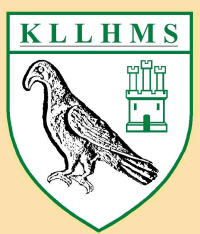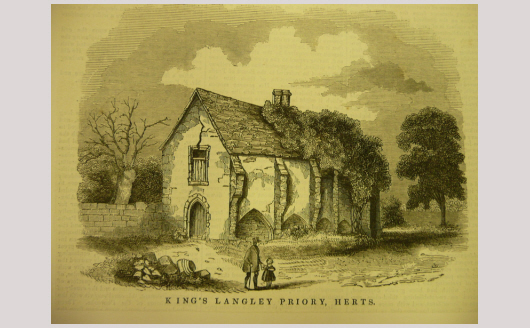The Priory
Edward II established a Dominican Friary at Kings Langley in 1308. The Friars Preachers, as they were called, were first housed in the King's own hunting lodge at Little London, between Kings Langley and Hunton Bridge 'until the place granted to them be built'. Provision was made at one time for as many as a hundred friars.
The friars' buildings and church were eventually constructed at the top of Langley Hill on land to the north of the Palace, but it was a long time before they were completed. Building records show that in the 1360s and 1370s the cloister was still being built, with a refectory and dormitory on the first floor above the cloister walk on two sides. There were also an infirmary and a chapter house. The materials used for the Friary were probably all local flints, with stone dressings from Totternhoe in Bedfordshire. The church itself was consecrated in 1312 and in 1315 the body of Piers Gaveston, the favourite of Edward II, was buried there after he had been murdered. However, the church too was still being constructed fifty years later.
In 1368 the church roof was leaded and a great striking bell was brought from London by Edward III to be mounted in the belfry. In the same year six stained glass windows were installed. The church when finished was longer than any other English Dominican church whose dimensions are known, except London Blackfriars.
The demise of the Friary
The Dissolution of the Monasteries under Henry VIII marked the end of the life of the Friary, although it was revived briefly as a nunnery in the reign of Queen Mary. When the Friary was dissolved it was found to be richer than any other house of Friars Preachers in England.
By 1678 the Friary land was in the hands of a gentleman, William Houlker, who destroyed the buildings except for one which is now called the Priory. This term although in general use is strictly a misnomer for this remaining part of the Dominican Friary appears to have been the Locutorium (a room in a monastery or the like where the inhabitants may converse with visitors or with each other).
In the early 19th century the building was in use for little more than a barn, while the Priory Church itself, the original burial place of Richard II and our own Edmund de Langley, had been reduced to rubble. It was thanks to Farmer Betts though that we do have some idea of the size of what has been described as "the finest Friary in England", for, in 1831 he had the good sense to record the dimensions and as much detail as he could of what remained before flattening the land to bring it into use for farming. To quote from the antiquarian Sir Gilbert Scott, visiting the site that year, he "found the farmer engaged with a number of men in excavating the site of the Monastic Church, because the foundations interfered with the fertility of the field.". Sir Gilbert, writing later, noted that, at the time he had felt that "the Church must have been as fine as Westminster Abbey, which, though no doubt an exaggeration, fairly expressed the general appearance of grandeur it created" with its fine proportions and its Purbeck marble bases to the pillars.
Excavations
The excavations of 1970 tentatively revealed a part of an outer edge of the church building and the outline of the Lady Chapel, also the cemetery; and part of the cemetery was uncovered by excavations in 1984.
Adapted from Palace, Priory and Mills KLH&MS (1987)
For an excellent history of Coombe Hill School please see
http://www.hertfordshire-genealogy.co.uk/





